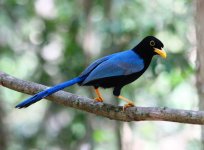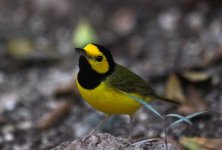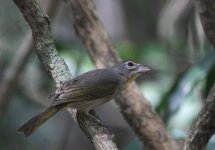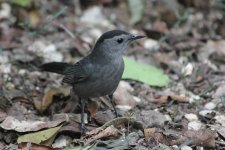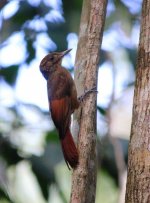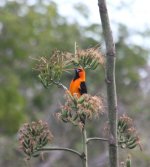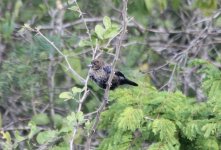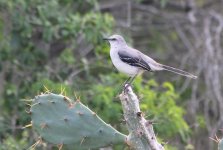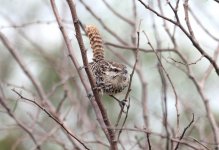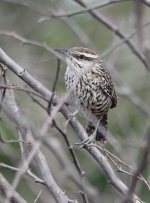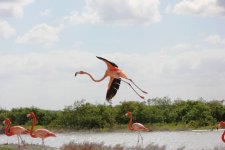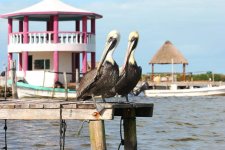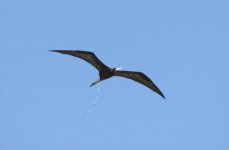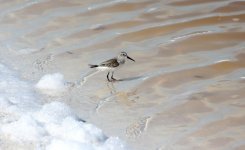ovenbird43
Well-known member

My husband and I just returned from a 1-week trip around the Yucatan Peninsula in Mexico. Since my husband isn't a birder and doesn't like to travel at the frenetic pace I often set during solo birding trips, I developed an itinerary that balanced my chances for most Yucatan endemics with keeping a leisurely pace (at least two nights per location) and time for other activities. So rather than the standard circuit, I cut out Felipe Carrillo Puerto and Calakmul - I figured this would sacrifice a few species, but I ended up seeing all the ones I was certain I would miss, while missing a few common ones!
Our overall itinerary was:
Jan 3-5: arrive Cancun, travel to Cozumel, with rental bikes and afternoon snorkeling
Jan 5-8: camping at Quintana Roo Natural Park, with a day trip to Coba ruins and biking around the park
Jan 8-10: Rio Lagartos, return to Cancun and fly out in the afternoon
Trip Planning:
I used Howell's book "A Bird Finding Guide to Mexico" for initial planning, and found most of the information still accurate. I also used RGallardy's recent trip report and other Surfbird reports referenced therein (http://www.birdforum.net/showthread.php?t=332234).
Transportation:
Flights from Syracuse, NY were relatively cheap ($350 round-trip) which is partly how I chose the destination vs. some other areas under consideration. We took the comfortable ADO bus from Cancun Airport to Playa del Carmen, where we caught one of the ferries to Cozumel. Ferry tickets can be bought all around Playa del Carmen in different kiosks, and prices vary stand to stand even within the same company - worth shopping around if you have the time. From the ferry dock in Cozumel, it was MX$50 for a taxi to the other side of the town where we stayed.
We rented bicycles from Rent a Bike Cozumel, US$76 for 1.5-day rental of 2 bikes with 1 emergency toolkit. I felt the bikes were quite good (compared to many others I saw on the streets) although they weren't quite to my husband's exacting standards - but he'll find things wrong with my own bike that I didn't even notice :-O. I highly recommend the company, they deliver and pick up their bikes, provide helmets and locks, and were our only experience during the trip with promptness and accuracy (in fact they were early for both pickup and delivery).
Following RGallardy's example in his trip report I rented a car from America Car in Playa del Carmen after our time on Cozumel, with plans to drop off at Cancun Airport for no extra charge. Our 5-day rental was $220 including full insurance - there were no surprise charges after the reservation quote, whereas other sites e.g. Expedia had quoted suspiciously low rates for other companies when I searched. My reservation email stated somebody from America Car would meet us at the ferry dock to take us to the office - this did not happen and it cost MX$100 to take a taxi to their office several kilometers away. The car was quite beat up and desperately needed a tire balance and rotation, and nobody had bothered to clean the windows, but it served us well.
Lodging:
Cozumel: We stayed at an AirBNB room for $26 per night. It was on the other side of town well away from the main tourist district. The place itself was fine, although we had many issues with arrival - the host had told me his girlfriend would be there to let us in, but she wasn't - fortunately some other guests were there to open the gate for us, but it was hours before we could get ahold of someone to give us a key. But it turned out there weren't any more keys - the girlfriend gave us her own key. They got more keys made the next day, but not before Tom got locked out for hours because he and I had decided on separate activities.
Quintana Roo National Park Campground: This is something of a rustic "ecolodge" which has a dormitory, several tents with air mattresses, and a small hut available as housing: http://quintanaroocampground.webs.com/ We rented one of the tents for $16/night. The campground is set 11 kilometers down a rough dirt road (takes nearly an hour to drive) from the highway between Tulum and Coba. The setting is nice and the surrounding forest provided excellent birding, including birds I had expected to miss by cutting out Calakmul and FCP (e.g. Gray-throated Chat, Ocellated Turkey). There is a kitchen, with some bread and eggs provided for a cook-your-own breakfast. Our air mattress had a slow leak but that actually proved comfortable for Tom and I - enough air for some support, but we both find stiff air mattresses give us back pain. The owner is a bit of a character - he has a nice set up with solar power, and can be entertaining to talk to, but he can also be a bit shady and rude. We wouldn't let up on one guest who had requested clean sheets for her air mattress, and he charged two visiting Germans MX$600 for a ride to Tulum (to which he was going anyway for groceries) while saying something about cheap rides from guys who would want to rape them - and then the very next evening he made a special trip the highway to pick up a group of 5 travelers, charging them only MX$50 each. There are 4 bikes available to use, thankfully free of charge as they were pretty awful - more on that later.
Rio Lagartos: we wanted to stay at Diego's posada or at his new Ria Maya lodge, but he didn't respond to my requests - perhaps he was booked up. We stayed at the Hotel Villa de Pescadores for $40/night. It was delightfully uneventful and unsurprising - the rooms were nice, with a balcony overlooking the estuary and a hummingbird feeder, good coffee available for breakfast, laundry service for MX$100, and functional wi-fi.
I'll post our daily log and some photos over the next few days.
Our overall itinerary was:
Jan 3-5: arrive Cancun, travel to Cozumel, with rental bikes and afternoon snorkeling
Jan 5-8: camping at Quintana Roo Natural Park, with a day trip to Coba ruins and biking around the park
Jan 8-10: Rio Lagartos, return to Cancun and fly out in the afternoon
Trip Planning:
I used Howell's book "A Bird Finding Guide to Mexico" for initial planning, and found most of the information still accurate. I also used RGallardy's recent trip report and other Surfbird reports referenced therein (http://www.birdforum.net/showthread.php?t=332234).
Transportation:
Flights from Syracuse, NY were relatively cheap ($350 round-trip) which is partly how I chose the destination vs. some other areas under consideration. We took the comfortable ADO bus from Cancun Airport to Playa del Carmen, where we caught one of the ferries to Cozumel. Ferry tickets can be bought all around Playa del Carmen in different kiosks, and prices vary stand to stand even within the same company - worth shopping around if you have the time. From the ferry dock in Cozumel, it was MX$50 for a taxi to the other side of the town where we stayed.
We rented bicycles from Rent a Bike Cozumel, US$76 for 1.5-day rental of 2 bikes with 1 emergency toolkit. I felt the bikes were quite good (compared to many others I saw on the streets) although they weren't quite to my husband's exacting standards - but he'll find things wrong with my own bike that I didn't even notice :-O. I highly recommend the company, they deliver and pick up their bikes, provide helmets and locks, and were our only experience during the trip with promptness and accuracy (in fact they were early for both pickup and delivery).
Following RGallardy's example in his trip report I rented a car from America Car in Playa del Carmen after our time on Cozumel, with plans to drop off at Cancun Airport for no extra charge. Our 5-day rental was $220 including full insurance - there were no surprise charges after the reservation quote, whereas other sites e.g. Expedia had quoted suspiciously low rates for other companies when I searched. My reservation email stated somebody from America Car would meet us at the ferry dock to take us to the office - this did not happen and it cost MX$100 to take a taxi to their office several kilometers away. The car was quite beat up and desperately needed a tire balance and rotation, and nobody had bothered to clean the windows, but it served us well.
Lodging:
Cozumel: We stayed at an AirBNB room for $26 per night. It was on the other side of town well away from the main tourist district. The place itself was fine, although we had many issues with arrival - the host had told me his girlfriend would be there to let us in, but she wasn't - fortunately some other guests were there to open the gate for us, but it was hours before we could get ahold of someone to give us a key. But it turned out there weren't any more keys - the girlfriend gave us her own key. They got more keys made the next day, but not before Tom got locked out for hours because he and I had decided on separate activities.
Quintana Roo National Park Campground: This is something of a rustic "ecolodge" which has a dormitory, several tents with air mattresses, and a small hut available as housing: http://quintanaroocampground.webs.com/ We rented one of the tents for $16/night. The campground is set 11 kilometers down a rough dirt road (takes nearly an hour to drive) from the highway between Tulum and Coba. The setting is nice and the surrounding forest provided excellent birding, including birds I had expected to miss by cutting out Calakmul and FCP (e.g. Gray-throated Chat, Ocellated Turkey). There is a kitchen, with some bread and eggs provided for a cook-your-own breakfast. Our air mattress had a slow leak but that actually proved comfortable for Tom and I - enough air for some support, but we both find stiff air mattresses give us back pain. The owner is a bit of a character - he has a nice set up with solar power, and can be entertaining to talk to, but he can also be a bit shady and rude. We wouldn't let up on one guest who had requested clean sheets for her air mattress, and he charged two visiting Germans MX$600 for a ride to Tulum (to which he was going anyway for groceries) while saying something about cheap rides from guys who would want to rape them - and then the very next evening he made a special trip the highway to pick up a group of 5 travelers, charging them only MX$50 each. There are 4 bikes available to use, thankfully free of charge as they were pretty awful - more on that later.
Rio Lagartos: we wanted to stay at Diego's posada or at his new Ria Maya lodge, but he didn't respond to my requests - perhaps he was booked up. We stayed at the Hotel Villa de Pescadores for $40/night. It was delightfully uneventful and unsurprising - the rooms were nice, with a balcony overlooking the estuary and a hummingbird feeder, good coffee available for breakfast, laundry service for MX$100, and functional wi-fi.
I'll post our daily log and some photos over the next few days.




